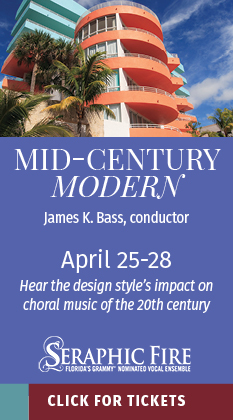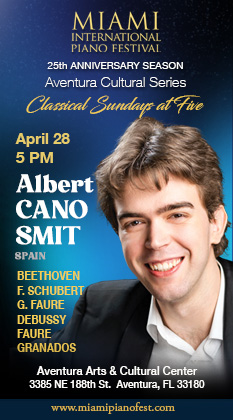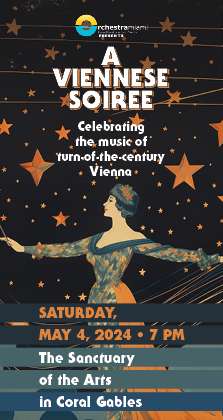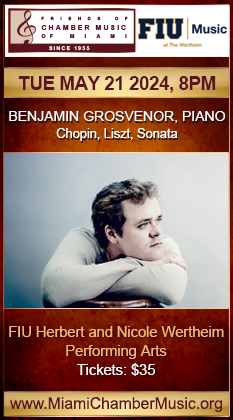Young Polish quartet makes admirable debut at Kravis

When the teenage Scottish violinist Nicola Benedetti issued her debut album in 2005, the major work on the disc was the Violin Concerto of Poland’s Karol Szymanowski.
As well as being a refreshing move, choosing that work for the recording introduced many more people to Szymanowski’s music: an unusual, distinctive brand of post-Straussian melodic and harmonic investigation that often, as in the Fourth Symphony, evokes the folk music of Poland. At the Kravis Center’s Rinker Playhouse on Monday night, a student string quartet from Krakow played this neglected master’s Second Quartet, and made a good case for it as a piece that deserves more frequent airings.
The Vistula Quartet is named after the storied river that runs through Krakow, where the quartet’s members — violinists Zofia Wojniakeiwicz and Oriana Bogdanowicz, violist Maria Dutka, and cellist Piotr Glusyznski — are students at the Academy of Music. Each of the four players is an adept instrumentalist, and the group’s basic ensemble was noticeably crisp and tight. It is also a group that could use a stronger musical profile and some alternative, less academic approaches to its repertoire.
The Szymanowski Second Quartet (Op. 56), written in 1927, is a relatively terse three-movement work that speaks the same kind of blunt language as the quartets of Bartok or Janacek—tonal, with recognizable forms and gestures, but filled with bone-crushing dissonance and savage, jagged motifs. Its first pages haunt, with a hushed, ghostly oscillation in second violin and viola over which the first violin and cello sing a melancholy line. Upheavals follow, with short, brutal bursts of ponticello bowing as the movement makes its way.
The Vistula’s cohesion worked well for them here, and Wojniakiewicz in particular played with much greater expressivity and power than in the Mozart quartet (No. 19 in C, K. 465, the Dissonant) that opened the first half. They also ably handled the agitation and the huge, thick chords of the second movement scherzo, which featured a leaping pizzicato workout for Gluszynski. The third movement, which begins with a fugue, required the same kind of rapid and texture change as the other two, and here, too, the Vistula was well up to the challenge.
Clearly, this was music of the heart for these young Polish musicians, and it came across with a palpable sense of passion. This performance showed there’s no good reason for sting quartets to skip Szymanowski when trying to vary their programs with more contemporary work.
The other two works on the program, the Mozart and the Mendelssohn quartet (No. 6 in F minor, Op. 80) that is getting much play in this bicentenary year for the composer, were approached in the same basic way, with scrupulous care, exceptional finish, and well thought-out interpretative nuance. These four players are a credit to their teachers, but what worked well for the Mozart wasn’t as useful in the Mendelssohn.
In the Mozart quartet, the overaching mood was that of gentleness and caution, as if the Vistula was worried something might break. Dynamics edged toward the soft, and there was not enough of that sense in the first movement of release and exuberance that comes out of the darkness of the mysterious introduction. The notable passage in that movement of sforzandi followed by rapid dynamic change wasn’t broad and dramatic enough to let the music move.
Everyone in the quartet seemed to be trying hard not to use much bow throughout the Mozart, and the result in the slow movement was a deeply quiet, delicate kind of calm that created a lovely mood (which the Rinker’s ushers did their best to disrupt by seating noisy late arrivals in the middle of the movement). But the next two movements needed more fire: higher spirits in the third, and more vigor in the finale. This was well-played Mozart, but also it was much too careful.
The Mendlessohn quartet that occupied the second half of the concert was the composer’s last major work, written in the midst of emotional agony over the death of his beloved sister, and it is unlike his other quartets — beautiful works all, and far too little played — in that it burns with a kind of Romantic heat that the composer rarely unleashed. As with the Mozart, the conception here was far too polite, although all the notes were in place, everyone played well together, and technique was irreproachable.
What was missing here was any feeling of rage, despair or agitation, which seems to me to be clearly required. The opening murmur in the violins, the twisting, rising motif in the middle of the theme, the triplets that litter the score like shell casings: All these were simply played well, but without enough drive or emotion.
The best example was the second movement, with its grinding, climbing main theme and its seesaw mini-passacaglia in the middle section. Instead of fury and tension, we got some interesting music in F minor; the most critical gap here was that of Gluszynski, who was much too unassertive, especially in this movement. The second movement’s primary theme relies on the harmony moving up in the bass, and the cellist has to hammer it out so we can hear it, and hear how it conflicts with the first violin. That didn’t happen, and the music was weaker because of it.
Finally, the beautiful third movement was merely soft and sweet, when it needs to be full of ardor. The quartet needs to do some work on playing phrases rather than just notes, so that the opening cello line would lead somewhere, and the first violin entrance, though marked with a soft dynamic, would nevertheless be rich, and full of the promise of the melody to come.
But these are the kinds of notes these fine young players — and they are good musicians — need to hear from their coaches in Krakow. The rest will come as life happens to them, and doubtless we’ll hear stronger readings of works such as the Mendelssohn F minor as their careers unfold. In the meantime, I’m grateful to them, as we should all be, for reminding us of the power and importance of Szymanowski.
Posted in Performances
Leave a Comment
Wed Mar 18, 2009
at 8:44 am
No Comments






